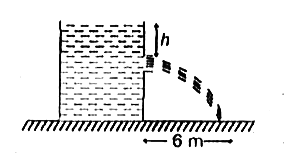A small disc A slides down with initial velocity equal to zero from the top of a smooth hill of height H having a horizontal portion. What must be the height of the horizontal portion h to ensure the maximum distance s covered by the disc? What is it equal to?

The correct Answer is:B
In order to obtain the velocity point (B), we apply the law of conservation of energy.
So,
Loss in PE=Gain in KE
mg(H−h)=12mv2
∴v=(√2g(H−h))
Further h=12>2
∴t=√2hg
Now, s=v×t=√[2g(H−h)]×√(2h/g)
or s=√[4h(H−h)] .....(i)
For maximum value of s, dsdh=0
∴12√[4h(H−h)]×4(H)=0 or h=H2
Substituting h=H/2 in E.q. (1), we get
s=√[4(h/2)(H−/2)]=√H2=H
Topper's Solved these Questions
- WORK, ENERGY & POWERBook:DC PANDEY ENGLISHChapter:WORK, ENERGY & POWERExercise:Exercise 9.1
Explore 10 Videos
- WORK, ENERGY & POWERBook:DC PANDEY ENGLISHChapter:WORK, ENERGY & POWERExercise:Exercise 9.2
Explore 9 Videos
- WORK, ENERGY & POWERBook:DC PANDEY ENGLISHChapter:WORK, ENERGY & POWERExercise:TYPE2
Explore 1 Video
- WAVE MOTIONBook:DC PANDEY ENGLISHChapter:WAVE MOTIONExercise:Integer Type Question
Explore 11 Videos
- WORK, ENERGY AND POWERBook:DC PANDEY ENGLISHChapter:WORK, ENERGY AND POWERExercise:MEDICAL ENTRACES GALLERY
Explore 33 Videos
Similar Questions
A ball is thrown from a point in level with velocity u and at a horizontal distance r from the top os a tower of height h.
At what horizontal distance x from the foot of the tower does the ball hit the ground ?
View SolutionA small disc of mass m slides down a smooth hill of height h without initial velocity and gets onto a plank of mass M lying on the horizontal plane at the base of the hill. (figure). Due to friction between the disc and the plank the disc slows down and, beginning with a certain moment, moves in one piece with the plank.
(1) Find the total work performed by the friction forces in this process.
(2) Can it be stated that the result of obtained does not depend on the choice of the reference frame?

View SolutionA small block of mass m is placed at rest on the top of a smooth wedge of mass M, which in turn is placed at rest on a smooth horizontal surface as shown in figure. If h be the height of wedge and θ is the inclination, then the distance moved by the wedge as the block reaches the foot of the wedge is
View SolutionA body is thrown with some velocity from the ground. Maximum height when it is thrown at 60∘ to horizontal is 90m. What is the height reached when it is thrown at 30∘ to the horizontal:-
View Solutiona body is thrown horizontally with a velocity √2gh from the top of a tower of height h. It strikes the level gound through the foot of the tower at a distance x from the tower. The value of x is :-
View SolutionA solid sphere of radius R is placed on a smooth horizontal surface. A horizontal force F is applied at height h from the lowest point. For the maximum acceleration of the centre of mass
View SolutionA solid sphere of radius R is placed on a smooth horizontal surface. A horizontal force F is applied at height h from the lowest point. For the maximum acceleration of the centre of mass
View SolutionA liquid is coming out from the orifice of tank and falls upto a maximum horizontal distance of 6 m. The height h is equal to

View SolutionA body is projected horizontally from the top of a hill with a velocity of 9.8 m/s. What time elapses before the vertical velocity is twice the horizontal velocity?
View SolutionA particle is projected with velocity u horizontally from the top of a smooth sphere of radius a so that it slides down the outside of the sphere. If the particle leaves the sphere when it has fallen a height a4 , the value of u is
View Solution